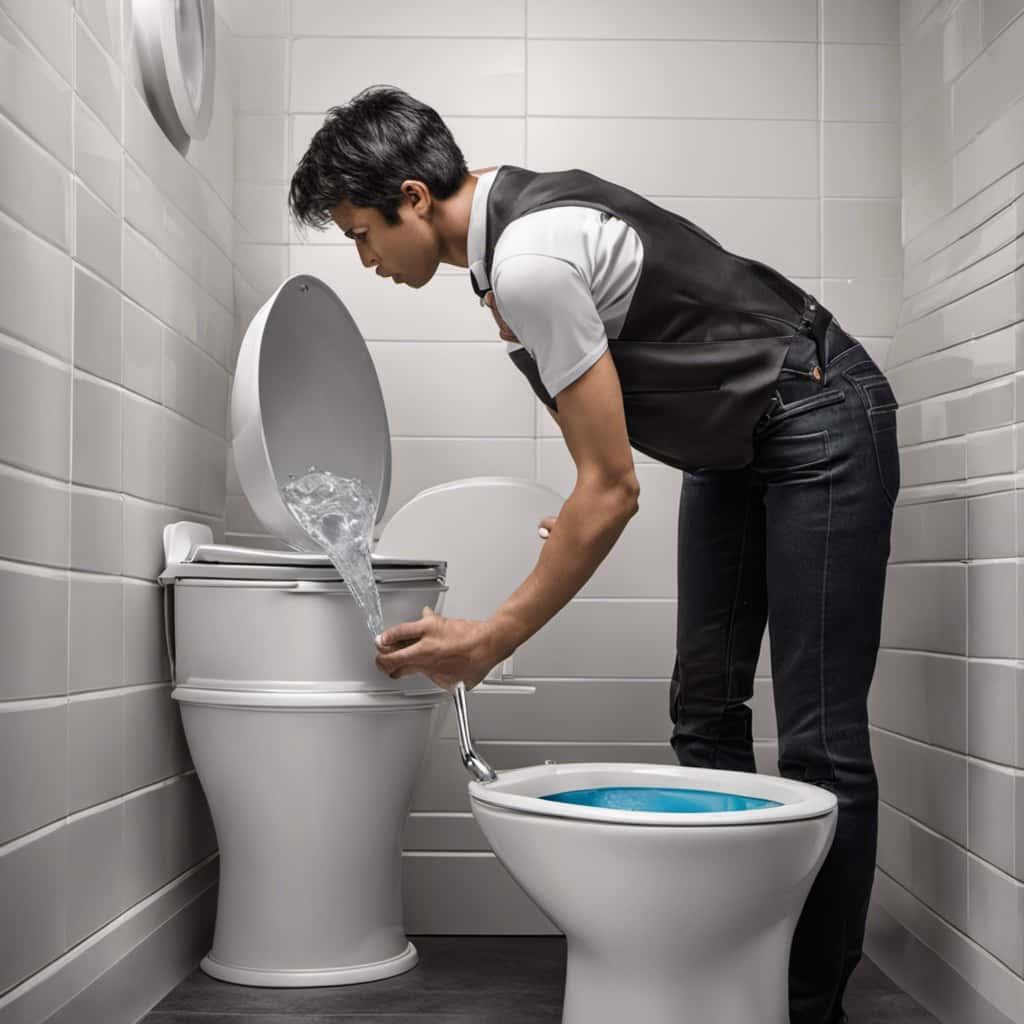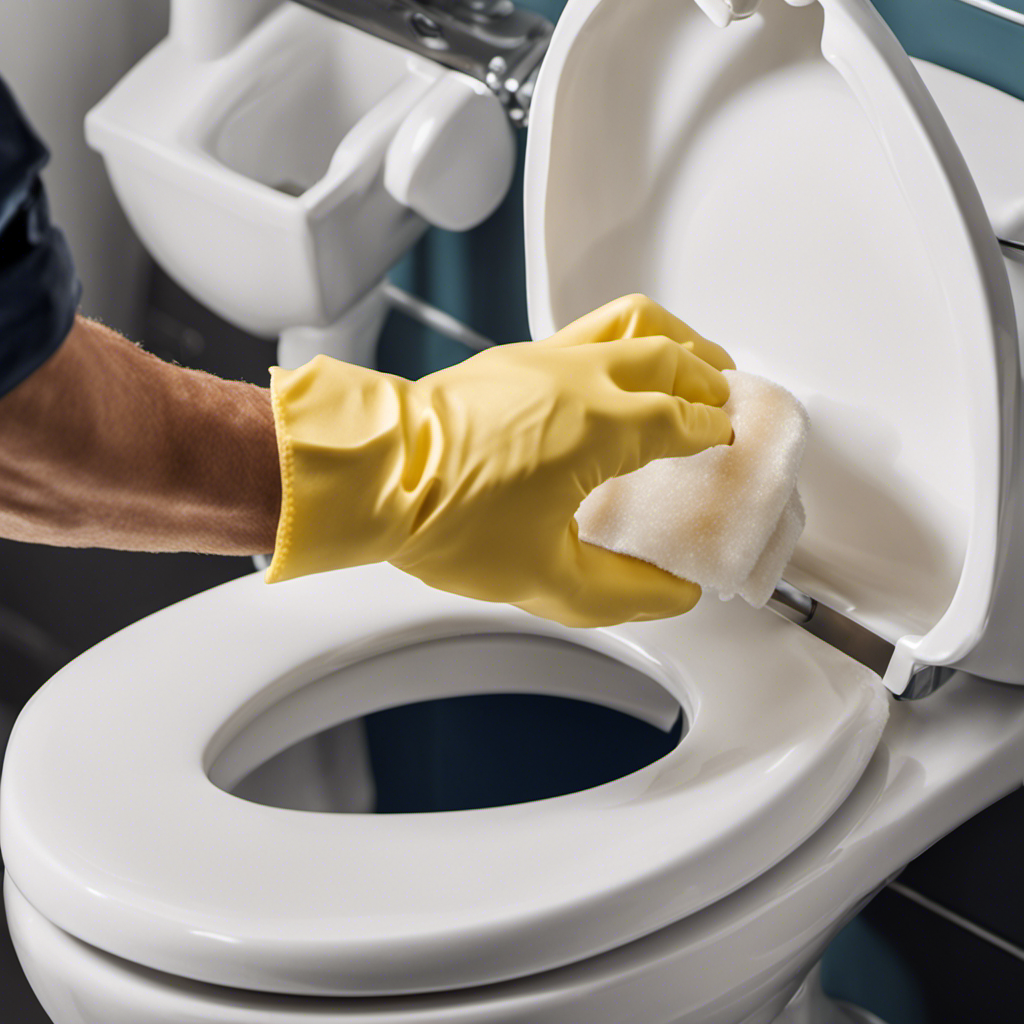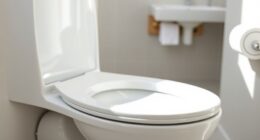We’ve all dealt with the annoyance of a blocked toilet.
But have you ever wondered if toilet paper will eventually unclog on its own?
In this article, we will delve into the composition of toilet paper, the breakdown process in plumbing systems, and the factors that affect its dissolvability.
We will also explore the environmental impact of unclogging toilet paper and provide tips to prevent future clogs.

Get ready to master the art of unclogging and keep your plumbing running smoothly.
Key Takeaways
- Toilet paper breaks down through water flow and microbial activity in plumbing systems.
- Factors like water pressure, temperature, and non-dissolvable items can affect the breakdown time of toilet paper.
- Water pressure and warmer water can enhance the dissolving process of toilet paper.
- Choosing easily flushable alternatives like biodegradable wipes or thinner toilet paper can help prevent toilet paper clogs.
Composition of Toilet Paper
Toilet paper comprises a combination of wood fibers and water, resulting in a soft and absorbent material. Understanding the composition of toilet paper is essential in comprehending the manufacturing process and exploring alternative options.
The manufacturing process begins with the debarking of logs, followed by the chipping and pulping of the wood fibers. These fibers are then mixed with water to form a slurry, which is further refined and treated with various chemicals to enhance strength and softness. The slurry is then processed through a paper machine, where it’s formed into a continuous sheet and dried.
Breakdown Process in Plumbing Systems
In our plumbing systems, the breakdown process of toilet paper occurs through a combination of water flow and microbial activity. When toilet paper is flushed, it enters the plumbing system where it’s exposed to water and subjected to the forces of water flow. This water flow helps to physically break down the toilet paper fibers, causing them to disintegrate over time.

Additionally, the presence of microbial activity in the plumbing system further aids in the breakdown process. Microbes, such as bacteria and fungi, can colonize the toilet paper, secreting enzymes that break down the cellulose fibers.
However, it’s important to note that the breakdown time of toilet paper can vary depending on factors such as water pressure, temperature, and the presence of non-dissolvable items. Flushing non-dissolvable items, such as wipes or sanitary products, can interfere with the breakdown process, leading to clogs and plumbing issues.
Therefore, it’s crucial to only flush toilet paper to ensure the proper functioning of our plumbing systems.
Factors Affecting Toilet Paper Dissolvability
Factors affecting the dissolvability of toilet paper include water pressure, temperature, and the presence of non-dissolvable items.

Water pressure plays a crucial role in the breakdown process of toilet paper in plumbing systems. Higher water pressure can enhance the dissolving process by effectively breaking down the fibers of the toilet paper.
Temperature also influences dissolvability, as warmer water helps to break down the paper more efficiently.
Additionally, the presence of non-dissolvable items, such as wet wipes or foreign objects, can impede the dissolving process and lead to clogs.
Understanding these factors is important not only for manufacturers in optimizing the toilet paper manufacturing process but also for individuals seeking alternative solutions to unclogging toilet paper.

Environmental Impact of Unclogging Toilet Paper
Understanding the dissolvability factors of toilet paper allows us to assess the environmental impact of unclogging it. When it comes to sustainability, it’s important to consider the recycling options for used toilet paper. While traditional toilet paper can be recycled, it is often contaminated with bodily waste, making it difficult to recycle efficiently. However, there are alternatives to traditional toilet paper that can help reduce the environmental impact. These alternatives include bamboo toilet paper, which is made from a renewable resource and biodegrades more easily, and recycled toilet paper, which is made from post-consumer recycled materials. By choosing these alternatives, we can minimize the environmental impact of unclogging toilet paper and promote a more sustainable future.
| Recycling Options for Used Toilet Paper | Alternatives to Traditional Toilet Paper |
|---|---|
| Recycle traditional toilet paper | Bamboo toilet paper |
| Recycled toilet paper | |
Tips to Prevent Toilet Paper Clogs
To prevent toilet paper clogs, we can employ effective strategies.
One option is to explore toilet paper alternatives that are designed to be more easily flushable, such as biodegradable wipes or thinner toilet paper. These alternatives can help reduce the risk of clogs by ensuring that the material breaks down more easily in water.
Another strategy is to educate ourselves about proper toilet paper usage. This includes using only the necessary amount of toilet paper and avoiding excessive amounts that can overwhelm the plumbing system.

Additionally, DIY unclogging methods can be employed to prevent clogs. For example, using a plunger or a drain snake can help dislodge any potential blockages in the toilet pipe.
Frequently Asked Questions
How Is Toilet Paper Made?
Toilet paper is made through a complex production process involving wood pulp, water, and chemicals. The environmental impact of toilet paper production is significant, as it requires the use of trees and consumes large amounts of water and energy.
What Other Materials Can Be Used as Toilet Paper?
What other materials can be used as toilet paper? There are several reusable alternatives that can be considered, such as bidets, washable cloth wipes, or even a water bottle. These options can help reduce the environmental impact caused by traditional toilet paper.
What Happens to Toilet Paper Once It Goes Down the Drain?
Toilet paper, once it goes down the drain, enters sewage systems where it can cause clogs if not properly disposed of. While some toilet paper can be recycled, it is important to follow local recycling guidelines to ensure proper disposal.

Does the Amount of Water Used in Flushing Affect the Breakdown of Toilet Paper?
The amount of toilet paper used in flushing does impact its breakdown. Excessive amounts can lead to clogs, causing environmental issues. It’s important to be mindful of our usage to prevent these problems.
Can Using Too Much Toilet Paper Lead to Clogs?
Using excessive amounts of toilet paper can lead to clogs. To prevent toilet paper clogging, consider alternative options such as bidets or wet wipes. Proper disposal and regular maintenance of plumbing systems are also crucial.
Conclusion
In conclusion, toilet paper is designed to dissolve in water and eventually unclog in plumbing systems. However, the rate of breakdown can vary depending on the composition of the toilet paper and other factors such as water flow and temperature.
Interestingly, studies have shown that most toilet paper brands can dissolve within 24 hours, with some even breaking down in as little as 4 hours. This statistic highlights the effectiveness of toilet paper in preventing clogs and reinforces the importance of using it responsibly.











